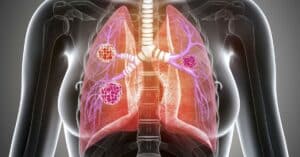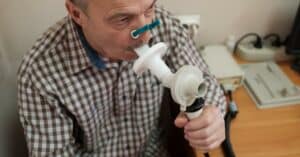There are two major types of chronic lung disease.
- Obstructive lung disease
- Restrictive lung disease
For example, chronic obstructive pulmonary disease (COPD) is an obstructive lung disease. Pulmonary fibrosis is an example of restrictive lung disease.
Obstructive and restrictive lung diseases share some common symptoms, such as shortness of breath, fatigue, and coughing. However, they are different types of lung disease.
Here is our complete guide to obstructive and restrictive lung disease to better inform you about these conditions and allow you to be more proactive in your healthcare.
How Are Obstructive And Restrictive Lung Diseases Diagnosed?
Measurements from a pulmonary function test (PFT) help doctors diagnose obstructive and restrictive lung disease. Pulmonary function tests measure how well your lungs are working.
Your doctor may recommend a pulmonary function test if your doctor suspects a chronic lung disease. Doctors use pulmonary function tests to diagnose lung disease, monitor the condition, and develop a treatment plan.
What Is An Obstructive Lung Disease?
People with obstructive lung disease have shortness of breath because they are not able to fully exhale all the air from their lungs. The air moves out of their lungs at a slower rate than that of a healthy person.
Inflammation and swelling narrow the airways, making it difficult to expel air from the lungs. Essentially, air becomes trapped within the lungs.
This is also known as increased residual volume. Increased residual volume leads to air becoming trapped in the lungs and to hyperinflation of the lungs.
Types of Obstructive Lung Disease
- Chronic Obstructive Pulmonary Disease (COPD)
- Emphysema
- Chronic Bronchitis
- Asthma
- Bronchiectasis
Obstructive Lung Disease Symptoms
- Shortness of Breath
- Chronic Cough
- Wheezing
- Sleep Apnea
- Production of Excess Mucus
- Chest Tightness
- Fatigue
- Frequent Respiratory Infections
What Are The Obstructive Lung Disease Stages And Life Expectancy?
Knowing your stage of obstructive lung disease helps you and your doctor understand the severity of your condition and develop a treatment plan.
Typically, doctors and researchers categorize obstructive lung diseases, such as COPD, into stages. The stages range from mild to very severe.
There are two common staging systems for COPD and other obstructive lung diseases. They are called the GOLD System and the BODE Index.
These stages are a way to measure disease severity, understand the overall prognosis, and approximate life expectancy.
GOLD System
The Global Initiative for Chronic Obstructive Lung Disease (GOLD) developed the GOLD System.
GOLD uses the forced expiratory volume in one second (FEV1) test from a pulmonary function test to categorize COPD. FEV1 shows the amount of air a person can forcefully exhale in one second.
People with obstructive lung disease have trouble exhaling all the air from their lungs, making breathing difficult. Airflow becomes more limited with each stage.
- Very Mild COPD or Stage 1: FEV1 about 80 percent or more of normal.
- Moderate COPD or Stage 2: FEV1 between 50 and 80 percent of normal.
- Severe COPD or Stage 3: Severe emphysema with FEV1 between 30 and 50 percent of normal.
- Very Severe COPD or Stage 4: A lower FEV1 than Stage 3, or those with Stage 3 FEV1 and low blood oxygen levels.
BODE Index
Other scientists developed the BODE Index. The BODE Index accounts for how COPD affects your life. BODE stands for body mass, obstruction of airflow, dyspnea and exercise capacity.
- Body Mass
- Obstruction of Airflow
- Dyspnea (difficulty breathing)
- Exercise Capacity
Body mass index (BMI) helps determine if you’re a healthy weight, underweight, overweight or obese. Obstruction of airflow shows the amount of airflow obstruction measured by your FEV1.
Dyspnea simply means difficulty breathing. Exercise capacity refers to exercise tolerance. A 6-minute walk test measures exercise tolerance. It also shows the distance you can walk in 6 minutes and evaluates your level of exercise tolerance.
The combined measurements make up the BODE Index.
Like the GOLD System, the BODE Index helps place COPD into stages and aids in approximating life expectancy. BODE Index calculators are available to help doctors and patients better estimate disease severity as well.
Obstructive lung diseases affect everyone differently. However, obstructive lung diseases, such as COPD and emphysema, are progressive and will worsen over time.
This makes assessing life expectancy challenging, so it’s important to talk with your doctor about any questions or concerns you have.
Obstructive Lung Disease Treatments
For best results, doctors individualize treatments for each person. Traditional treatments include a variety of medications, inhalers, steroids, and anti-inflammatories.
Bronchodilators are a common treatment and are used to relax the airways. This helps the airways stay open. Bronchodilators are taken through an inhaler, so the medicine goes straight to your lungs.
There are short-acting and long-acting forms of bronchodilators. Short-acting bronchodilators work quickly, while long-acting bronchodilators provide longer-lasting relief.
There are two types of bronchodilators: beta-agonists and anticholinergics. Beta-agonists work to relax tightened muscles in the airways. Anticholinergics help prevent the muscles around the airways from tightening, and they can help clear mucus from your lungs.
Combination inhalers are another common treatment. They combine two different medications into the same inhaler. For example, some combination inhalers combine bronchodilators and inhaled steroids.
Oral steroids may help reduce inflammation. Antibiotics help treat infections.
Natural treatments can help manage obstructive lung disease symptoms as well. These may include herbs, dietary supplements, complementary medicine and lifestyle modifications. These natural treatments can help you stay healthy and avoid flare-ups.
What Is A Restrictive Lung Disease?
People with restrictive lung disease cannot fully fill their lungs with air and cannot fully expand their lungs. This makes it difficult to take a full breath.
Often, restrictive lung disease results from a condition causing stiffness in the lungs themselves.
Types of Restrictive Lung Disease
Restrictive lung diseases are categorized as intrinsic and extrinsic. Certain types of restrictive lung disease called intrinsic restrictive lung disorders have lung problems from within the lungs.
Simply put, intrinsic restrictive lung disorders cause restriction of the lungs and lung problems from inside the lungs. Intrinsic restrictive lung diseases include:
- Interstitial lung disease
- Idiopathic pulmonary fibrosis
- Pulmonary Fibrosis
- Sarcoidosis
- Pneumoconiosis
Sometimes, the restriction is caused by weak muscles, stiffness in the chest wall or damaged nerves and are known as extrinsic restrictive lung disorders.
This means that the restriction and lung problems originate from outside of the lungs. The lungs are affected from something besides having a disease within the lungs. This means that other diseases cause problems for the lungs from something outside the lungs.
Extrinsic restrictive lung disorders include:
- Obesity
- Pleural Effusion
- Myasthenia gravis
- Scoliosis
- Neuromuscular disease, such as muscular dystrophy or Lou Gehrig’s Disease (ALS)
Restrictive Lung Disease Symptoms
- Shortness of Breath
- Dry Cough
- Weakness
- Fatigue
- Weight Loss
- Achy Joints
What Are The Restrictive Lung Disease Stages And Life Expectancy?
Traditionally, the restrictive lung disease stages are termed mild, moderate, severe, early and advanced. Doctors categorize the condition based on the results from a pulmonary function test.
Restrictive lung disease affects everyone differently. However, many forms of restrictive lung disease, such as interstitial lung disease and pulmonary fibrosis, are progressive and will worsen over time.
Life expectancy depends on a variety of factors based on each individual person, so it’s important to talk with your doctor about your questions and concerns.
Restrictive lung disease is characterized by reduced total lung capacity (TLC). Total lung capacity represents the amount of air present in the lungs after taking the deepest breath possible.
A pulmonary function test determines total lung capacity. Knowing the total lung capacity of someone with restrictive lung disease is important to confirm lung restriction and to measure the degree of restriction.
In fact, there are new developments in the restrictive lung disease stages. Doctors and researchers have been working on a more sophisticated staging system called the GAP Index.
GAP Index
The GAP Index has four predictors. These predictors are age, recent respiratory hospitalization, baseline forced vital capacity or FVC and 24-week change in FVC. The sum of the individual scores for each factor is used to obtain a score.
Doctors and researchers continue to improve the GAP Index, using a multidimensional risk prediction model and staging system.
This GAP Index model has four baseline variables. The variables are gender, age and two lung physiology variables (FVC and diffusing capacity of carbon monoxide).
Most of all, this research helped them create a GAP Index calculator for doctors and patients to better understand disease severity.
Restrictive Lung Disease Treatments
Many types of restrictive lung diseases are progressive, meaning they will worsen over time. However, treatments are available and vary depending on the patient’s individual needs.
For example, Esbriet and Ofev are two FDA-approved medications that may be used to treat idiopathic pulmonary fibrosis, which is a type of restrictive lung disease. However, there are other types of treatments, too.
Many people with restrictive lung disease take medications that work to reduce inflammation and suppress the immune system. These medications include corticosteroids, azathioprine, cyclophosphamide, and methotrexate.
Oxygen therapy helps maintain blood oxygen levels for people with low blood oxygen levels. Doctors may recommend lung transplantation surgery in severe or end-stage restrictive lung disease cases.
What are the Differences between Obstructive Lung Disease and Restrictive Lung Disease?
Obstructive and restrictive lung diseases are two different types of lung disease. Obstructive lung disease makes it difficult to fully exhale all the air from your lungs. They are obstructed from taking in more air.
People with obstructive lung disease typically produce excess mucus, causing a smoker’s cough. FEV1 is an important measurement used to diagnose and categorize obstructive lung disease.
Restrictive lung disease makes it difficult to fill the lungs with air. They are restricted from taking a full breath.
People with restrictive lung disease have a dry cough, which may produce some white sputum. FVC and TLC are important measurements used to diagnose and categorize restrictive lung disease.
While obstructive and restrictive lung disease both have staging systems, they use different measurements to place the condition into a stage. For some people, their condition progresses rapidly, and for others, it progresses slowly.
Both obstructive and restrictive lung disease are progressive conditions and will worsen over time.
Use this complete guide to obstructive and restrictive lung disease as a resource. Remember, having the information you need helps you stay proactive in your healthcare, so feel free to discuss it with your doctor.

Christine Kingsley, APRN is the Health and Wellness Director at the Lung Institute where she focuses on providing helpful online resources for people looking for information on various lung diseases, breathing exercises, and healthy lifestyle choices. She advocates for holistic care that involves working with your doctor to explore all options including traditional and alternative care while focusing on diet and exercise as proactive measures.









